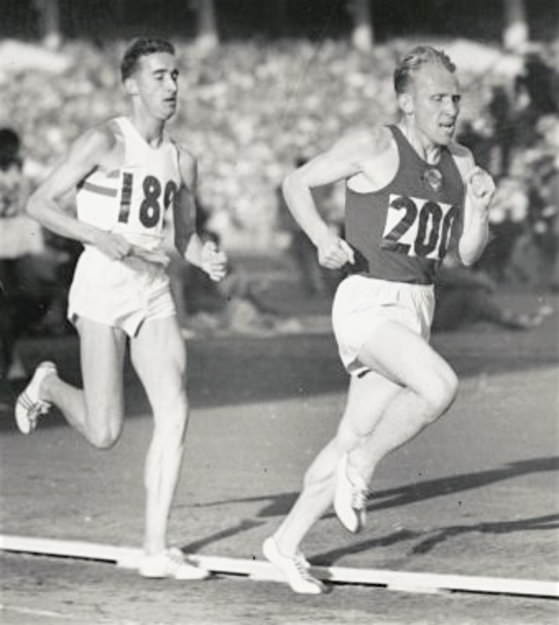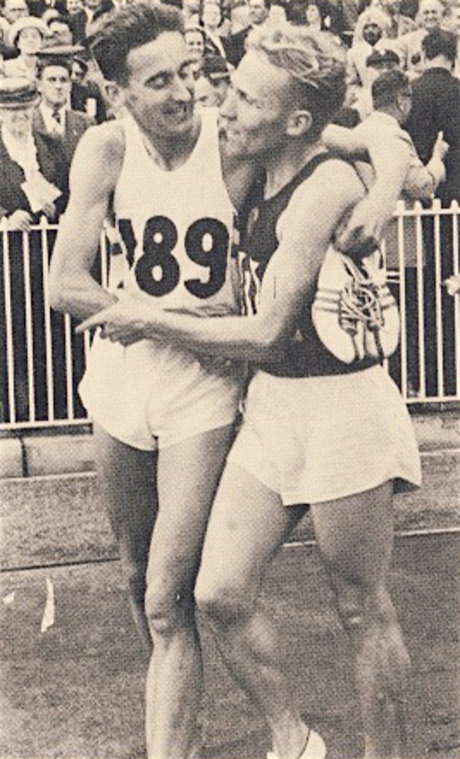Pirie v Kuts
Olympic 10,000, Melbourne, 1956
Great Races # 11
This epic 1956 distance race featured a classic struggle between a front runner and a fast finisher. Although the race was an Olympic final, there were only two runners in contention almost from the gun. Vladimir Kuts and Gordon Pirie were so much better than the other competitors that their duel took place well ahead of the field, despite the erratic pace that evolved through tactics.
 |
| Kuts pushes the pace from the start. |
It was the first distance race of the Games. Sandor Iharos of Hungary, a former WR holder and thus a favorite, didn’t make it to the start line—the obvious reason being the recent Soviet invasion of his country. His absence meant that there were two clear favorites: Vladimir Kuts (29) of the USSR, who had broken Iharos’s WR just a couple of months earlier with a 28:30.4 clocking, and Briton Gordon Pirie (25), who had a best 47 seconds slower than the WR of Kuts but had by far the better finish.
Pirie had been in great form in the European summer with WRs over 3,000 and 5,000. Also in the picture was Jozsef Kovacs, a very consistent 10,000 runner from Hungary, who had been 3rd, 2nd and 2nd in the three previous years’ world rankings. Emil Zatopek, who had dominated distance running since 1948 but was now past his best and had opted to run only the marathon.
It was clear that Kuts’s best chance was to break the field with a fast pace; he would have little chance in a sprint finish. Although he had almost matched Chataway’s sprint in London two years earlier, he had experienced the power of Pirie’s finish in a 5,000 earlier in the year. Also supporting the choice of a fast-pace tactic was Kuts’s earlier victory from the front in the 1954 Euro 5,000. Indeed, Kuts had the temperament of a front runner: he was consistent and strong-willed to the point of being ruthless.
Pirie’s tactic was just as obvious: hang on to the Russian until the last lap. He knew from his 5,000 WR in Bergen earlier in the year that he could easily outsprint the Russian on the last lap. But his strength over the longer 10,000 was still suspect, his best time being only 29:17.2 compared to Kuts’s 28:30.4. Further, Kuts had beaten Pirie over 10,000 in London on September 11, 1955. Pirie was also strong-willed, but he was more temperamental than the Russian. He tended to run either brilliantly or poorly.
There was a rare false start for this race; an obviously nervous Pirie was the culprit. Nevertheless, the tall gangly Brit was soon on Kuts’s shoulder as the red-vested Russian roared into the lead. The first lap was almost 4-minute mile speed at 61.2. After two laps the Australian runners moved up, and one of them accidentally clipped the Russian’s heels. He responded by surging away from the field. “A fantastic burst” Pirie called it. (Running Wild, p.156) He, of course, went with the Russian. The two runners were already clear of the field.
 |
| Pirie hangs on during Kuts's "lung-searing dashes." |
After the 61 lap, Kuts steadied to 68’s for the next three, which still kept him under 28:00 pace. Then in the fifth lap Kuts began to employ his famous surges—“terrific lung-searing dashes,” as Pirie called them (RW, p.156). This initial burst took Kuts 7 meters ahead of Pirie, but the Brit soon made up the deficit. A 64.7 lap. The next lap slowed to 71. Then Kuts pulled out and invited Pirie to lead. Pirie declined and the cat-and-mouse game continued. The 3,000 was reached in 8:26, 28:07 pace.
With Pirie shadowing Kuts so closely, the tenor of the race began to change. As Cordner Nelson stated in his excellent eye-witness coverage of this race (T&FN, Dec. 56, p.12), “Now Pirie gave the illusion of being the hunter, with Kuts the victim.” Still, Kuts continued his effort to break Pirie. After a burst, he would slow so quickly that a surprised Pirie stumbled several times to avoid a collision. Pirie later said that he found these changes of pace so energy sapping that he couldn’t take the lead and stop Kuts surging. Kuts even tried running in the third lane. In fact the track was so loose—Pirie said it was “like sand” (RW, p.156)-- that both runners often avoided the inside lane.
So Pirie had to let Kuts do all the work and thus lost all control of the pace. After laps of 67.1, 68.8, 67.6 and 69, the 5,000 was reached in 14:06.8, which was within two seconds of the 12th ranked 5,000 runner for 1956 and was equal to Zatopek’s Olympic 5,000 record. Kuts continued to invite Pirie to take the lead, but the offer was always declined and was always followed by another sapping burst by Kuts on the back straight. Not surprisingly, this intense dueling led to a drop in the overall pace.
But not for long. After two laps of 71, Kuts put in a 66. The sixteenth lap slowed to 73 as Kuts pulled out and waved Pirie past. Pirie declined. So Kuts put in another surge on the seventeenth lap (69.3). It now appeared that Pirie had his opponent’s measure. The pace slowed: 72.7, 70.9. Then on the back stretch of the twentieth lap Kuts almost stopped and Pirie found himself leading. But Kuts was back in the lead by the end of the lap. Five laps to go.
 |
| Kuts and Pirie showtheir mutual respect after the race. |
Kuts now began to slow somewhat. Was it possible that he was about to break? Pirie began to think he had the race in the bag as Kuts had slowed to 72.4. But on the 22nd lap (68.5), Kuts put in another surge that finally broke Pirie. He was 4m down by the end of that lap. The last straw was probably a psychological let-down following Pirie’s belief that he had survived all that Kuts could throw at him. With his rhythm gone, Pirie fell right back to finish 8th. Now all Kuts had to do was hold on to win. Psychologically buoyed by breaking Pirie, he managed to do this with laps of 69.4, 70.3 and 66.7. However, his winning margin was only 6.8 seconds at the end as Kovacs and Lawrence closed fast in the later laps, fighting their own private battle for silver.
The Russians told Pirie later that Kuts was also on his last legs with four laps to go. If Pirie had been able to match that last burst, they said, Kuts would have dropped out. Kuts, indeed, confirmed this many years later. Such is the small margin between winning and losing. Pirie had correctly sensed that Kuts was almost spent, but the gallant Russian had the courage to try one more time to break Pirie. This was one of the great duels in distance running. Norman Harris can be excused for his exaggerated description of this race as a “fight to the death.” (Running: The Power and the Glory, p.62) In fact, Pirie used the same hyperbole after the race: “He murdered me—that’s all there was to it.” (Track & Field News)
Kuts came to be universally admired for his courage. Roger Bannister, who was reporting on the games for Sports Illustrated, wrote, “Despite the lack of any outstanding gifts, Kuts is admirable for the manner in which he made himself by sweat, toil and tears.” (SI, Jan. 7, 1957) Pirie, who was forever at loggerheads with the press, was treated harshly after his loss. But in truth he performed brilliantly. And he might well have beaten the Russian if he had been able to withstand that one last burst.
Result: 1. Vladimir Kuts USSR 28:45.6; 2. Jozsef Kovacs HUN 28:52.4; 3. Allan Lawrence AUS 28:53.6; 4. Zdzislaw Krzyshkowiak POL 29:05.0; 5. Ken Norris GBR 29:21.6; 6. Ivan Chernyavskiy USSR 29:31.5. 
1 Comment